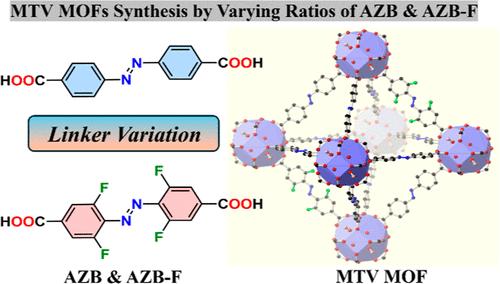Photoactivated Multivariate Metal–Organic Frameworks for On-Demand Drug Release: The Role of Host–Guest Interactions
IF 14.4
1区 化学
Q1 CHEMISTRY, MULTIDISCIPLINARY
引用次数: 0
Abstract
The development of smart drug delivery vehicles capable of controlled release upon application of an external stimulus is of paramount interest for the next generation of personalized medicine. Herein, we report a series of six multivariate (MTV) MOFs capable of visible light-activated drug delivery. The drug loading capacity and release rates were systematically tuned through variation of the linker ratio between 4,4′-azobenzene dicarboxylic acid (H2ABDA) and 4,4′-(diazene-1,2-diyl)bis(3,5-difluorobenzoic acid) (H2ABDA(3,5-F)). The drug loading capacity, dictated by host–guest interactions, was thoroughly explored via a combined experimental and computational approach using two model drug or drug-like molecules, 5-fluorouracil (5-FU) and Nile Red. Notably, the loading capacity for 5-FU follows a “Goldilocks” profile with a maximum loading at 33% H2ABDA(3,5-F) content. Computational results confirm the existence of a cooperative ligand environment that promotes strong, preferential binding at the tetrahedral/octahedral pore window formed between two H2ABDA and one H2ABDA(3,5-F). Thus, the MTV approach enhanced capacity over the native 100% H2ABDA(3,5-F) and 0% H2ABDA(3,5-F) MOFs. In addition to increased loading, the rate of cargo release upon green light excitation also increased as the percentage of H2ABDA(3,5-F) in the MOF was raised, reaching a maximum release rate of 0.9 ± 0.1% of total cargo per minute for the MOF containing 100% H2ABDA(3,5-F) MOF. The results highlight the promise of MTV MOF design for optimizing drug delivery vehicles with relevant payloads and patient-dictated dosing.

求助全文
约1分钟内获得全文
求助全文
来源期刊
CiteScore
24.40
自引率
6.00%
发文量
2398
审稿时长
1.6 months
期刊介绍:
The flagship journal of the American Chemical Society, known as the Journal of the American Chemical Society (JACS), has been a prestigious publication since its establishment in 1879. It holds a preeminent position in the field of chemistry and related interdisciplinary sciences. JACS is committed to disseminating cutting-edge research papers, covering a wide range of topics, and encompasses approximately 19,000 pages of Articles, Communications, and Perspectives annually. With a weekly publication frequency, JACS plays a vital role in advancing the field of chemistry by providing essential research.

 求助内容:
求助内容: 应助结果提醒方式:
应助结果提醒方式:


